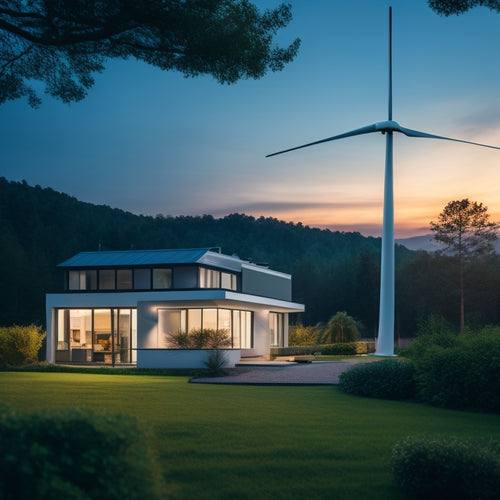
5 Essential Tips for Motorhome Inverter Systems Online
Share
When setting up your motorhome's inverter system, you'll need to take into account a few important factors to guarantee reliability and efficiency. First, calculate your total power demand to choose the right inverter size, and don't forget to slightly oversize it for unexpected surges. Next, look for high-efficiency ratings to minimize energy waste, and select a compatible battery type designed for deep cycling. Proper inverter placement, ventilation, and cable management are also vital. Finally, ensure a safe installation by following local codes and taking precautions to prevent electrical shock. As you delve deeper, you'll uncover more details to optimize your system.
Key Takeaways
• Calculate total power demand to select the right inverter size, considering all appliances and their wattage ratings.
• Choose an inverter with a high efficiency rating to minimize energy wastage and heat loss.
• Select a compatible battery designed for deep cycling, with low maintenance requirements and sufficient capacity.
• Ensure proper inverter placement with good airflow, ventilation, and organized cables to reduce electromagnetic interference.
• Follow safety guidelines during installation, including proper grounding, secure mounting, and using cables that can handle maximum current output.
Choosing the Right Inverter Size
When selecting an inverter for your motorhome, determining the right size is essential to make sure you can power your appliances safely and efficiently. To get it right, you need to calculate your inverter load, which is the total power demand of all the appliances you plan to run simultaneously. This includes lights, laptops, refrigerators, and any other device that will be drawing power from your inverter.
To calculate your power demands, make a list of the appliances you'll be using and their respective wattage ratings. Add up the total wattage to determine your peak power requirement.
It's important to oversize your inverter slightly to account for any unexpected power surges or spikes. A general rule of thumb is to add 10-20% to your total power demand to make sure your inverter can handle the load safely.
Understanding Inverter Efficiency Ratings
Now that you've determined the right inverter size, it's equally important to understand how efficiently it converts DC power to AC power, which is where inverter efficiency ratings come into play.
Inverter efficiency ratings indicate how much of the DC power is converted to usable AC power, and how much is lost as heat. A higher efficiency rating means less energy wastage and heat loss, resulting in a safer and more reliable motorhome inverter system.
When selecting an inverter, look for efficiency ratings, usually expressed as a percentage. A higher rating indicates that more of the DC power is converted to usable AC power. For example, an inverter with a 95% efficiency rating means that 5% of the DC power is lost as heat, while 95% is converted to usable AC power.
Opting for an inverter with a high efficiency rating will reduce heat loss, minimize energy wastage, and establish a more reliable and efficient motorhome inverter system.
Selecting Compatible Battery Types
You'll need to pair your inverter with a compatible battery type to guarantee a reliable and efficient motorhome inverter system. The right battery type will ensure your inverter operates safely and efficiently, while the wrong one can lead to system failures and even safety hazards.
When selecting a battery type, consider the following factors:
-
Deep Cycling: Choose a battery designed for deep cycling, which can handle frequent discharge and recharge cycles.
-
Battery Maintenance: Opt for a battery with low maintenance requirements to minimize upkeep and maintain consistent performance.
-
Capacity: Select a battery with sufficient capacity to meet your power needs, taking into account factors like appliance loads and usage patterns.
- Compatibility: Verify that the battery is compatible with your inverter's voltage and charging requirements to maintain seamless operation.
Optimizing Inverter Placement Design
Proper inverter placement is essential to maintain efficient cooling, reduce electromagnetic interference, and prevent electrical shock, so it's important to strategically locate your inverter in your motorhome. When deciding where to place your inverter, consider ventilation considerations. You'll want to guarantee good airflow around the inverter to prevent overheating, which can lead to reduced performance or even complete system failure.
Look for a location that allows for adequate airflow, such as near a vent or in a well-ventilated area.
Additionally, cable management is critical when it comes to inverter placement. You'll want to keep cables organized and secured to prevent damage or electrical shock. Consider using cable ties or zip ties to keep cables tidy and out of the way. This will also help reduce electromagnetic interference, which can impact the performance of your inverter and other electrical systems in your motorhome.
Ensuring Safe Inverter Installation
When installing your motorhome's inverter, it's crucial that you follow safety guidelines to prevent electrical shock, fire hazards, or even system failure. You've invested in a reliable inverter, but improper installation can render it useless.
To guarantee a safe and efficient setup, consider the following:
-
Grounding methods: Make sure your inverter is properly grounded to prevent electrical shock. Consult your motorhome's electrical codes and manufacturer's instructions for specific guidelines.
-
Electrical codes compliance: Familiarize yourself with local electrical codes and regulations to avoid system failure or electrical hazards.
-
Proper cable sizing: Use cables that can handle the inverter's maximum current output to prevent overheating and fire risks.
- Secure installation: Mount the inverter securely to prevent vibrations, moisture, or physical damage that can lead to system failure.
Frequently Asked Questions
Can I Use a Motorhome Inverter With a Regular Household Outlet?
Can you really expect a motorhome inverter to work seamlessly with a regular household outlet? Well, it depends on outlet compatibility and voltage conversion. You'll need an inverter that matches the outlet's voltage and current rating to guarantee safe, efficient power conversion.
How Often Should I Replace the Inverter's Internal Cooling Fan?
You should replace the inverter's internal cooling fan every 5-7 years or when you notice decreased fan reliability and cooling efficiency, ensuring peak performance and preventing overheating hazards in your motorhome.
Are There Any Specific Inverter Settings for Different Appliances?
"Imagine hosting a dinner party: you prioritize guests, allocating resources accordingly. Similarly, you'll want to prioritize appliances, allocating power with inverter settings, ensuring your motorhome's limited energy is utilized efficiently and safely for each device."
Can I Charge My Motorhome's Battery While the Inverter Is On?
"When you're running your inverter, you can charge your motorhome's battery simultaneously, but prioritize battery safety by ensuring the inverter's power priority settings don't compromise charging efficiency or overall system stability."
Do Motorhome Inverter Systems Require Any Maintenance Schedules?
Think of your motorhome's inverter system like a car's oil change - regular maintenance is key! You should regularly review Inverter Logs and perform Scheduled Checks to guarantee peak performance and safety, just like you would with your vehicle.
Related Posts
-

7 Best Geothermal Cooling Systems for Hot Climate Homes
You're evaluating geothermal cooling systems for your hot climate home, and you want to know the top options. Look fo...
-

10 Grid-Tied Wind Power Systems for Modern Homes
You're looking for a grid-tied wind power system to utilize wind energy for your modern home. Here are ten options to...
-

7 Smart Air Purification Hacks for Energy-Savvy Homes
You can notably improve your indoor air quality while minimizing energy consumption by implementing strategic air pur...


